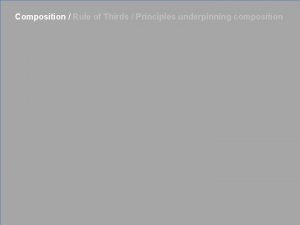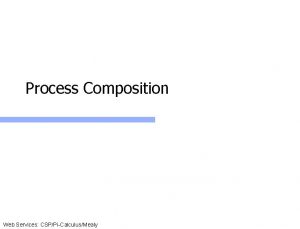The Production Process Composition The Production Process is











- Slides: 11

* The Production Process + Composition

*The Production Process is the term used to describe the different steps involved in producing a final video project/production. *There are three major steps in the process: - Pre Production* - Post-Production* *

* Pre-Production: Pre-Production is the planning stage of the production process Generating ideas, script, storyboard, screenplay, etc. * Production: The actual filming of the video production Creating sets, choosing costumes, filming scenes, etc. * Post- Production: Editing the video and the audio Adding special effects, titles, credits, formatting for different screens, etc. *

*Each step is crucial for the step it precedes. If the Pre-Production stage is overlooked or done poorly, both Production and Post-Production will be directly affected. *Therefore, it is important to address all of the stages with care. *

Production Elements used to tell a “story”: • Visuals (a variety of shots and footage) may also include still photos or images • Voice-over or Narration • Textual Elements (Titles and or Graphics) • Sound (music, special effects and sound effects, voice) used to create mood *

Content: Content = Story – What is the story? A story includes an intro, body, conclusion (requires a Plot) Remember to answer the 5 Ws – Where, When, Why, What, Who? And also How? Why is the story relevant to the Audience? Who is your Audience? (TARGET MARKET) When producing a video and live elements for the show, please keep the fundamentals of “storytelling” in mind. *

Also think about: Composition The RULE OF THIRDS (Rule of thumb) A basic rule of composition is the rule of thirds. This guideline gives you ideas on where to place your subject within the frame. Though your tendency may be to position your subject dead center on the screen, the rule of thirds will give you a more compelling/dynamic picture. *

Things to think about: Composition The Rule of Thirds The guideline proposes that an image should be imagined as divided into nine equal parts by two equally-spaced horizontal lines and two equally-spaced vertical lines, and that important compositional elements should be placed along these lines or their intersections. Placing points of interest along the lines or at the intersections tends to create a more interesting composition. * Scene from movie: Braveheart

Things to think about: Composition FRAMING Using Objects While objects in the background can cause problems, objects placed in the foreground can lend a hand. This technique can add depth and character to your shot. Try using something in the environment to obstructed part of your shot. Place a piece of furniture in your foreground and shoot past it by framing it to the extreme right or left. You can shoot through open doors, where the door jamb frames the edges of the screen. Be careful, however, not to over-do it. Using the environment to frame your shots should not be so blatant as to distract from what is happening in the scene. * Eternal Sunshine of the Spotless Mind; http: //www. youtube. com/watch? v=l. FHLE 24 h. DQY

Things to think about: Composition The Ultimate Goal Good composition is a means to an end. When it's done well, the audience should notice it. Instead it should help create a mood, or at the very least, a sense of normalcy and stability. The next time you watch a movie, pay attention to how the cinematographer frames the shots. You'll notice that they use the rule of thirds as their foundation, and build from there. *

Rule of thirds exercise: Exercise Handout + Exercise Posted on server and on the class website: http: //missmeschino. weebly. com/unit-4 -video. html Look under Video Exercises & Tutorials: 2. Compostion_Rule of Thirds Activity





















